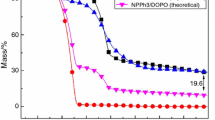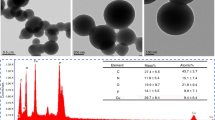Abstract
The aim of this work was to study the effect of tris(3-nitrophenyl) phosphine (NPPh3), which showed a good thermal stability and carbon-forming ability, on the flame retardancy and thermal degradation mechanism of epoxy resins. A series of diglycidyl ether of bisphenol A (DGEBA) loaded with tris(3-nitrophenyl) phosphine (NPPh3) were prepared. It was found that NPPh3 can effectively improve the flame retardancy and thermal stability of the composites. When the loading amount of NPPh3 was 14%, the LOI value of the DGEBA composites was 29.2% (about 1.53 times the corresponding value of the original DGEBA resin). Thermal stability was studied by thermogravimetric analysis, and the results showed that the addition of NPPh3 can improve char formation of this system both in nitrogen and in air atmosphere. Specifically, its combustion residue at 800 °C in nitrogen atmosphere was about 4.26 times of the original resin. Differential scanning calorimetry indicated that NPPh3 slightly decreased the glass transition temperature of epoxy resins. Additionally, the gaseous degradation products were analyzed by thermogravimetric analysis/infrared spectrometry, providing insight into the thermal degradation mechanism. Scanning electron microscopy and Fourier transform infrared were brought together to evaluate the morphology and structure of the residual char obtained after combustion.










Similar content being viewed by others
References
Hu J, Shan J, Zhao J, Tong Z. Isothermal curing kinetics of a flame retardant epoxy resin containing DOPO investigated by DSC and rheology. Thermochim Acta. 2016;632:56–63.
Zhao W, Liu J, Peng H, Liao J, Wang X. Synthesis of a novel PEPA-substituted polyphosphoramide with high char residues and its performance as an intumescent flame retardant for epoxy resins. Polym Degrad Stab. 2015;118:120–9.
Yang S, Wang J, Huo S, Wang J, Tang Y. Synthesis of a phosphorus/nitrogen-containing compound based on maleimide and cyclotriphosphazene and its flame-retardant mechanism on epoxy resin. Polym Degrad Stab. 2016;126:9–16.
Zhang T, Liu W, Wang M, Liu P, Pan Y, Liu D. Synergistic effect of an aromatic boronic acid derivative and magnesium hydroxide on the flame retardancy of epoxy resin. Polym Degrad Stab. 2016;130:257–63.
Zhang W, Fina A, Cuttica F, Camino G, Yang R. Blowing-out effect in flame retarding epoxy resins: insight by temperature measurements during forced combustion. Polym Degrad Stab. 2016;131:82–90.
Liu S, Fang Z, Yan H, Chevali VS, Wang H. Synergistic flame retardancy effect of graphene nanosheets and traditional retardants on epoxy resin. Compos A Appl Sci Manuf. 2016;89:26–32.
Huo S, Wang J, Yang S, Wang J, Zhang B, Zhang B, Chen X, Tang Y. Synthesis of a novel phosphorus-nitrogen type flame retardant composed of maleimide, triazine-trione, and phosphaphenanthrene and its flame retardant effect on epoxy resin. Polym Degrad Stab. 2016;131:106–13.
Tan Y, Shao ZB, Yu LX, Xu YJ, Rao WH, Chen L, Wang YZ. Polyethyleneimine modified ammonium polyphosphate toward polyamine-hardener for epoxy resin: thermal stability, flame retardance and smoke suppression. Polym Degrad Stab. 2016;131:62–70.
Wang S, Xin F, Chen Y, Qian L, Chen Y. Phosphorus-nitrogen containing polymer wrapped carbon nanotubes and their flame-retardant effect on epoxy resin. Polym Degrad Stab. 2016;129:133–41.
Zhang M, Luo Z, Zhang J, Chen S, Zhou Y. Effects of a novel phosphorus–nitrogen flame retardant on rosin-based rigid polyurethane foams. Polym Degrad Stab. 2015;120:427–34.
Xu GR, Xu MJ, Li B. Synthesis and characterization of a novel epoxy resin based on cyclotriphosphazene and its thermal degradation and flammability performance. Polym Degrad Stab. 2014;109(109):240–8.
Ding J, Tao Z, Fan L, Yang S. Preparation and characterization of flame retardant epoxy resins based on phosphorus-containing biphenyl-type phenolic resin. e-Polymers. 2010;10(1):1372–84.
Sun S, He Y, Wang X, Wu D. Flammability characteristics and performance of halogen-free flame-retarded polyoxymethylene based on phosphorus–nitrogen synergistic effects. J Appl Polym Sci. 2010;118(1):611–22.
Xiao L, Sun D, Niu T, Yao Y. Syntheses and characterization of two novel 9,10-dihydro-9-oxa-10-phosphaphenanthrene-10-oxide-based flame retardants for epoxy resin. Appl Phys A. 2014;118(4):1365–70.
Zhang X, Zhong Y, Mao ZP. The flame retardancy and thermal stability properties of poly (ethylene terephthalate)/hexakis (4-nitrophenoxy) cyclotriphosphazene systems. Polym Degrad Stab. 2012;97(8):1504–10.
Wang SB, Wang LS. Synthesis and application of triphenylphosphine and its derivates. Mod Chem Ind. 2006;26(6):66–9.
Agrawal S, Narula AK. Synthesis and characterization of phosphorus containing aromatic poly(amide-imide)s copolymers for high temperature applications. Polym Bull. 2013;70(12):3241–60.
Bai CY, Tang XD, Chen XT, Zhang JH. Synthesis and characterization of bis(3-aminophenyl)phenyl phosphine oxide. Chem Reag. 2010;32(5):470–2.
Chen X, Ma C, Jiao C. Enhancement of flame-retardant performance of thermoplastic polyurethane with the incorporation of aluminum hypophosphite and iron-graphene. Polym Degrad Stab. 2016;129:275–85.
Yang Y, Liu J, Cai X. Antagonistic flame retardancy between hexakis(4-nitrophenoxy) cyclotriphosphazene and potassium diphenylsulfone sulfonate in the PC system. J Therm Anal Calorim. 2016;126(2):571–83.
Xu MJ, Ma Y, Hou MJ, Li B. Synthesis of a cross-linked triazine phosphine polymer and its effect on fire retardancy, thermal degradation and moisture resistance of epoxy resins. Polym Degrad Stab. 2015;119:14–22.
Bao X, Cai X. Synergistic effect of methyl phenyl silicone resin and DOPO on the flame retardancy of epoxy resins. J Therm Anal Calorim. 2014;118(1):369–75.
Xu MJ, Xu GR, Leng Y, Li B. Synthesis of a novel flame retardant based on cyclotriphosphazene and DOPO groups and its application in epoxy resins. Polym Degrad Stab. 2016;123:105–14.
Zhang L, Wang Y, Liu Q, Cai X. Synergistic effects between silicon-containing flame retardant and DOPO on flame retardancy of epoxy resins. J Therm Anal Calorim. 2016;123(2):1–8.
Yang S, Wang J, Huo S, Cheng L, Wang M. Preparation and flame retardancy of an intumescent flame-retardant epoxy resin system constructed by multiple flame-retardant compositions containing phosphorus and nitrogen heterocycle. Polym Degrad Stab. 2015;119:251–9.
Ding H, Wang J, Wang C, Chu F. Synthesis of a novel phosphorus and nitrogen-containing bio-based polyols and its application in flame retardant polyurethane sealant. Polym Degrad Stab. 2016;124:43–50.
Zhang T, Liu W, Wang M, Liu P, Pan Y, Liu D. Synthesis of a boron/nitrogen-containing compound based on triazine and boronic acid and its flame retardant effect on epoxy resin. High Perform Polym. 2016;29(5):513–23.
Zhang L, Wang Y, Cai X. Effect of a novel polysiloxane-containing nitrogen on the thermal stability and flame retardancy of epoxy resins. J Therm Anal Calorim. 2016;124(2):791–8.
Xu W, Wirasaputra A, Liu S, Yuan Y, Zhao J. Highly effective flame retarded epoxy resin cured by DOPO-based co-curing agent. Polym Degrad Stab. 2015;122:44–51.
Wang P, Yang F, Li L, Cai Z. Flame retardancy and mechanical properties of epoxy thermosets modified with a novel DOPO-based oligomer. Polym Degrad Stab. 2016;129:156–67.
Author information
Authors and Affiliations
Corresponding author
Rights and permissions
About this article
Cite this article
Luo, H., Yang, Y., Cao, X. et al. Thermal degradation mechanism and flame retardancy of epoxy systems containing tris(3-nitrophenyl) phosphine. J Therm Anal Calorim 132, 1629–1637 (2018). https://doi.org/10.1007/s10973-018-7081-6
Received:
Accepted:
Published:
Issue Date:
DOI: https://doi.org/10.1007/s10973-018-7081-6




